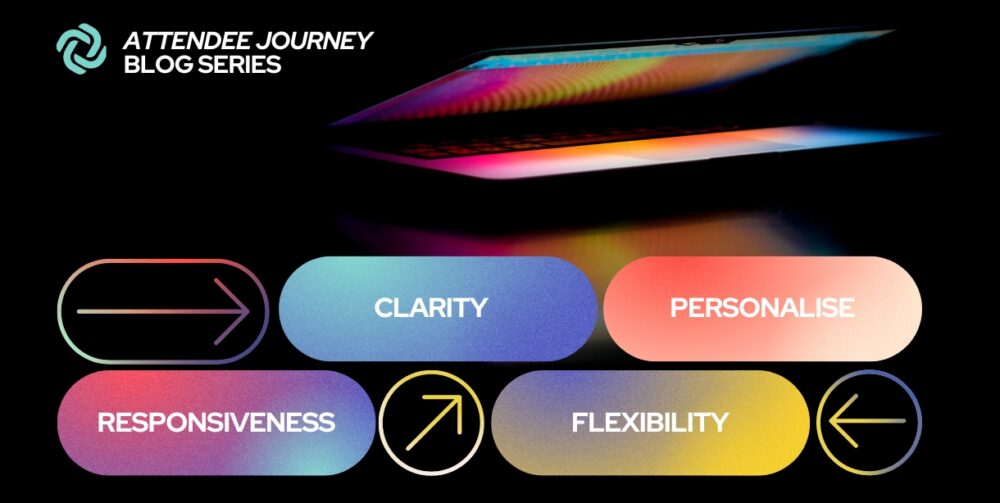Essential registration strategies: how to optimise for maximum attendance and peak user experience

Welcome to the first blog in our series on designing and optimising effective attendee journeys.
Here, we’ll share expert insights, frameworks, and actionable best practices suitable for businesses, organisations, and institutions alike.
Whether you’re new to the world of event planning and management, or you’re looking to elevate and refine your strategies, this series is designed to be your guide to improving all aspects of attendee engagement.
Join us as we explore ways to make your events more engaging and accessible, starting with the crucial process of event registration, and driving towards measurable outcomes such as increased relevant attendance, enhanced participant satisfaction, and higher conversion and retention rates. Let’s begin!
Why is having an optimised event registration important?
Envision the perfect scenario, where as an event organiser you’ve nailed driving the right crowd to your event:
- You’ve streamlined the event page, making it pop with engaging introductions, great visuals, and crystal-clear details to spike event registrations. Plus, you proactively cleared any potential objections with a well-crafted FAQ and refund policy section, smoothing the path for your attendees.
- You built excitement by hooking your audience early with incentives like early bird packages. This strategy not only piques interest but also encourages prompt action.
- You maximised email marketing by embedding registration links in your emails, sending periodic reminders, and sweetening the deal with early bird offers. This approach keeps your event top-of-mind and makes signing up more appealing.
- You connected during the registration window by keeping the conversation going with content and social buzz. This engagement lifts attendance and earnings by making attendees feel involved and excited.
- You facilitated group sign-ups by offering group registration options. This makes signing up more convenient and encourages participation.
- You empowered sharing and influencer engagement by kicking off a referral program and teaming up with industry influencers. Focusing on those with engaging followers and a brand vibe that matches your event, you expanded your reach and credibility.
But as you prepare for your event, remember this: regardless of how much know-how, time and resources a business or organisation invests in its attendee journey—From brand awareness to conversion-focused web design—the substantial, and often overlooked, success factor hinges on the key moments before the registration.
Any amount of friction can cause your audience to hesitate and abandon. The checkout isn’t the end of the registration process, it’s often the deciding factor. By using the latest technology to build a frictionless online reg, businesses can benefit from double-digit registration numbers uplift. Let’s see how.
How to optimise your event registration, the iVent way
Navigating the world of event planning, we’ve spotted a universal truth: attendees crave simplicity and speed. Even in the B2B world, attendee expectations are skyrocketing, partly because of an unconscious comparison with the seamless experiences of B2C shopping checkouts.
At iVent, over the years we developed a framework for a seamless event registration process online, and it boils down to four key principles:
1. Clarity
- Did you know? Low page load speed and a confusing website interface are among the top reasons for shopping cart abandonment [1].
- Consider this: sixty percent of customers say they would abandon a website if a purchase took more than two minutes to complete.
A straightforward path is what everyone wants. By streamlining the event registration process to its essence, we ensure attendees can glide through it seamlessly, sidestepping any potential hiccups. KISS: keep it simple, stupid.
What to do:
- Once a customer has added all of their personal and payment details, allow them to store the information so you can pre-populate the form fields next time they register for a following event.
- Display payment method logos and security credentials on every page of the checkout process to reinforce confidence and trust in your business or organisation, and clear any residual doubts or objections they might have about the safety of their personally identifiable information (PII) and financial data.
This is straight out of Steve Krug’s playbook in “Don’t Make Me Think,” leading users by the hand, so they don’t have to wonder about the next step.
- Only ask essential questions during checkout; reserve nice-to-have info for post-registration and post-event surveys. Every extra field is a roadblock on their journey.
2. Personalisation: Make it their own
Personalising the event registration experience means digitally greeting each attendee with open arms, ready to cater to their specific needs and preferences. This approach could result in these registration process improvements:
- Showcasing payment options tailored to each attendee’s preference, ensuring the checkout is as smooth as their favourite online shopping experience.
- Recognising returning attendees, making them feel valued and seen, as if they’re coming back to a familiar place where everyone knows their name.
Everyone wants to feel seen. By tailoring the event registration experience, attendees not only feel special but are more likely to come back.
3. Responsiveness: mobile is king
The average desktop checkout abandonment rate is between 25% to 35%, and mobile abandonment rates are up to 30% higher than the desktop version [2]. Responsiveness to us means three things:
- 📱Mobile-first design
In an era where smartphones are extensions of ourselves, ensuring your registration page is mobile-friendly isn’t optional—it’s essential. If they can’t sign up on their phone without squinting or zooming, you might have just lost them. - 🤳🏽An abandoned checkout can potentially be invaluable
Use exit surveys on your website to learn why people decide to leave the site and inform next fixes and improvement iterations. - 🕳️ Dig deeper: don’t let the journey end at ‘Submit’
The principle of responsiveness goes beyond a mobile-friendly design. Immediate confirmation of registration and a clear outline of the next steps are also essential.This approach ensures attendees are fully informed about what to expect next, and also increases the likelihood of attendance—especially for free and complimentary ticket holders.Stay tuned, as we promise to delve deeper into post-registration best practices in an upcoming instalment of our series on enhancing your attendees’ journeys.
Pro tip: abandoned registration email strategy
To address the issue of registration abandonment, businesses can use techniques such as exit-intent popups, personalised messaging, and re-engagement strategies to reduce shopping cart abandonment [3].
An effective re-engagement strategy consists of deploying automated emails to those who began the registration process but didn’t finish.
These reminders often contain a direct link to pick up where they left off, sometimes sweetened with a special discount or incentive to nudge them towards completing their registration.
Employing this tactic on event registration platforms proves highly effective for salvaging sales that might otherwise slip through the cracks and for boosting conversion rates.
4. Open your options with flexibility
The registration system needs versatility, supporting a wide range of event types, from free or paid events to recurring gatherings or lecture series. It should also accommodate extras, offering options like VIP packages.
Moreover, embracing modern payment solutions, including subscriptions and flexible “buy now, pay later” plans, widens the system’s appeal. This ensures every attendee finds a payment method that matches their needs, making your events more accessible and inclusive.
Enhancing the registration journey further, consider integrating the following key login enhancements to provide a smoother experience for your attendees:
- Main authenticators and social logins: Incorporate login options through well-known platforms such as Google, Microsoft, and LinkedIn. This approach not only streamlines the registration process but also leverages the trust and security associated with these established services.
- Magic links: Implement magic links to provide a password-free login experience. Attendees receive a unique link via email that grants them direct access to the event, simplifying entry and bolstering security without the hassle of remembering passwords. This method is particularly user-friendly, aligning with the convenience modern attendees expect.
- Use a ticketing solution that lets you embed the checkout on their website as a widget
Lastly, the system should support on-demand registration, allowing attendees to register and access event content at their convenience. This feature is essential for extending the lifespan of your event’s content and accommodating attendees across different time zones or schedules, ensuring no one misses out due to timing conflicts.
Bring the checkout to your attendees: so far you’ve learned how to improve the conversion rate on your event registration page. But what if your attendees didn’t have to come to your website or digital venue to check out?
Paid events: how to increase the likelihood of a purchase.
Businesses and organisations can surface relevant information earlier in the sales funnel to streamline a sale:
- Return and resell policies: communicate return and resell policies upfront
- Buy now, pay later options: let customers know you accept instalment payments prior to checkout so they know you offer flexible payment options.
- Validating payment fields in real time also minimises the risk of transactional errors.
We’ve found that prioritising these principles while building your event registration will help drive attendance numbers, no matter how you get there.
Whether someone is making a purchase online or registering for an event, the end goal is the same: to make the process as smooth, intuitive, and user-friendly as possible.
Businesses and event organisers can learn from the principles of clarity, personalisation, responsiveness and flexibility for an optimised checkout to refine their checkout processes. A win-win situation: doing so not only elevates the event registration experience for attendees but also enhances conversion rates.
 Achraf Kibir
Achraf Kibir